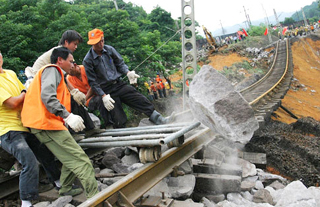 |
The death toll from this year's floods
has continued to rise with 567 people now confirmed dead and a
further 165 missing.
???
In total, more than 2.45 million people have been evacuated to
safety from floods, landslides and mudslides, the result of
torrential rains, the Ministry of Civil Affairs said on
Friday.
???
Direct damage caused by the calamities was estimated at up to 22.9
billion yuan (US$2.7 billion).
???
"So far this year, the loss is worse than average, but still below
the figures in 1991 and 1998" when devastating floods wreaked havoc
across eastern and central China, a source with the ministry,
said.
???
Since mid-June, at least 124 people have been killed and 69 others
are missing in flood-battered Guangdong,
Fujian, Jiangxi, Zhejiang and Hunan provinces and the Guangxi
Zhuang Autonomous Region, he said.
???
About 60 percent of China's total losses so far were recorded in
these provinces where more than 18.8 billion people were affected
by flooding and landslides with 1.5 million displaced.
???
Among them, Guangxi, Fujian and Guangdong were the worst hit, with
6.9 million people, 2.18 million and 2.56 million affected
respectively.
???
This week alone, 39, 19 and 53 deaths have been confirmed in
Guangxi, Fujian and Guangdong respectively. By yesterday afternoon,
the regions were still "plagued by floods with rain-swollen rivers
raging across areas downstream," a source with the State Flood
Control and Drought Relief Headquarters said.
???
In Guangxi, at its peak flooding, the Xijiang River ripped through
Wuzhou at a record flow of 53,300 cubic meters per second at the
downstream Gaoyao Hydrometric Station.
???
"The flood is now advancing on the Pearl River Delta downstream,"
the source said, warning that the torrent could threaten the delta,
one of China's most prosperous areas.
???
In Guangdong, the water level in the Xijiang River was still at a
dangerous level on Friday, threatening many cities.
???
"The province is still on high alert for possible floods," said Li
Ronggen, vice-governor of Guangdong.
???
In Fujian, water levels in the province's largest river, the
Minjiang, was receding slowly but remained just 0.5 meters below
the danger level.
???
The state flood-control headquarters urged authorities to intensify
patrols along the rain-swollen rivers and prevent soaked levees
from collapsing with the fast subsiding floodwaters.
???
Railways suspend operation
???
At least 18 trains were suspended along the Beijing-Guangzhou
Railway and the Xiamen Railway Station in Fujian also stopped
operating following the recent floods and landslides.
 |
???
Regular trains from Beijing to Shenzhen, and from Jiangxi's
Nanchang to Fuzhou, capital of Fujian, and Xiamen in Fujian were
also cut off, said local media.
???
By Friday evening, more than 4,000 railway workers and soldiers
were working round-the-clock to repair tracks destroyed by
landslides along the Huizhou to Longchuan section of the
Beijing-Kowloon railway line.
???
Lu Dongfu, vice-minister of railways, has also arrived in Guangdong
to help direct railway operations and track repair work.
???
A total of 15 passenger trains running on the Beijing-Kowloon
Railway have stopped operating since Wednesday. Railway officials
have urged passengers to take planes, or coaches instead or make
railway detours to reach their destinations.
???
"When the operation of the Guangdong Section of the Beijing-Kowloon
Railway is to be resumed is still unknown," an executive from
Guangdong Railway Group Corporation told China Daily on Friday.
???
Local forecasters have warned that Guangdong's weather will remain
unstable into the coming week.
(China Daily June 25, 2005)
?